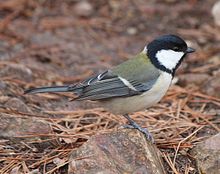BIFF!
Oh no, are you all right? Didn't you hear me warn you about that low-flying goose?
Oh yes I did. I said watch and out, and everyone knows that's a warning of danger.
What? You mean I have to say the words in the right order for it to make sense?
Oh.
*
The ordering of words is called syntax*, and until recently only humans were thought to have a language system in which it was important. Now, however, studies of Japanese Tits:

Japanese Tit
by Toshitaka N Suzuki, David Wheatcroft, and Michael Greisser have shown that they combine their chirrups and tweets in particular orders to make new meanings.
When the call for come here is combined with a predator warning sound, for instance, it acts as a sign for the whole flock to come together; but when the order of the calls was reversed in a recording the birds no longer knew what they were supposed to do.
According to Dr David Wheatcroft of Uppsala University, the study 'demonstrates that syntax is not unique to human language, but also evolved independently in birds'.
I suppose that's probably true...unless some common dinosaur ancestor of birds and humans had a language system that relied upon syntax.
Did a tyrannosaurus' grrrr-chomp! mean something entirely different from chomp-grrrr?
It'd be good to know, wouldn't it?
Word To Consider Today: syntax. This word comes from the Greek suntaxis, from suntassein, to put in order, from tassein, to arrange.
A syrinx, by the way, is the bird equivalent of the human larynx.
*No, sadly not the ultimate cure for austerity.
No comments:
Post a Comment
All comments are very welcome, but please make them suitable for The Word Den's family audience.